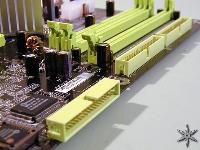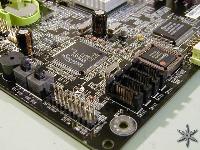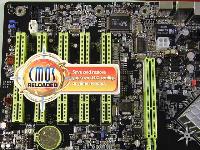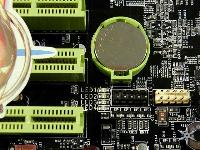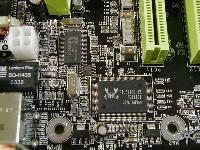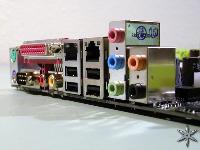After careful consideration I have decided to transfer all hardware review activities to a new domain. I purchased Hardwareasylum.com in 2012 and have been working hard to build a new and improved Ninjalane on that domain. If you are reading this you have reached one of the archived articles, news, projects and/or reviews that were left behind during the site migration.
Please update your bookmarks and be sure to visit the new and improved Ninjalane at Hardwareasylum.com
DFI LanParty NFII Ultra Rev B Motherboard Review
Author: Dennis Garcia
Published: Friday, January 16, 2004
Board Layout and Features Cont.
Drive connectors are situated inline along he edge of the board. Some of you may recognize the angled floppy connector as being used on Abit motherboads. Since the floppy connector is inline with the PCI slots it was angled to provide extra clearance.
A new feature on the LanParty NFII Ultra Rev B is the inclusion of a 4-port SerialATA RAID controller from Silicon Image. According to the controller documentation this controller supports all current 150 SerialATA drives and RAID levels 0, 1, 1+0.
Something that hardware enthusiasts and gamers have been doing for years is to situate expansion cards at least one slot away from the video card. This would allow more airflow to the card and keep it cooler. The expansion slots on the DFI LanParty NFII Ultra are situated to allow for this and still retain full usage of the remaining PCI slots.
LanParty motherboards come with a diagnostic system comprised of 4 LEDs. These will light up during the booting process to help troubleshoot issues that may arise. A map of what each LED configuration means is located in the user manual.
GigaLAN comes standard on all high-end DFI motherboards and is quickly becoming the standard for all wired LAN connections. Aside from the built in nVidia LAN the NFII Ultra also comes with this GigaLAN chip from Realtek.
The ATX connector contains ports for all of the major included features with the exception of IEEE1394 (Firewire), you will need to use the FrontX connector for that.

